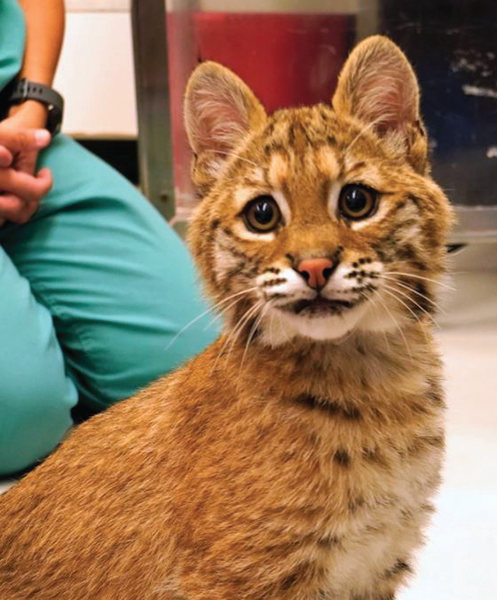Dottie the bobcat was only 3 months old when she arrived at the Cornell University Hospital for Animals (CUHA). Her keepers at the Claws ‘n’ Paws Wild Animal Park in Lake Ariel, Pa., noticed a limp in her hind legs and suspected she had fallen from a fence in her enclosure. Images taken at the local veterinarian’s office showed a small fracture in Dottie’s femur bone, so they referred her to CUHA for further care.
The Cornell exotics service team sedated Dottie for radiographs and found that the young cat had septic arthritis in her left hip and a secondary fracture of the femur. The Cornell veterinarians sent the bobcat home on antibiotics to clear the infection before any surgery, saying the bacteria likely entered through an injury lower on the leg and traveled up the leg to the hip.
When her infection cleared and there were no signs of healing of the femur fracture, Dottie was brought back to CUHA, where they prepped her for a surgery known as a femoral head ostectomy (FHO). “The procedure eliminates the ball portion of the ball-and-socket joint so that it shifts the responsibility of weight bearing onto the muscles and tendons instead,” says Dr. Ricardo de Matos, senior lecturer in the Zoological Medicine section.
Dr. Ursula Krotscheck, section chief of Small Animal Surgery, performed the operation. “Over a few months, scar tissue develops around what used to be the hip joint to make a ‘false’ joint, which will help the hips support the leg and bear weight,” she says. “While it doesn’t function as well as a true hip joint, our patients typically have excellent quality of life and fairly good range of motion after they recover.”
While FHO procedures are primarily performed in domestic cats and dogs, the same process of the operation applied to the wild cat, except that the unusual feline patient required more sedation to ensure safety of the bobcat and the staff.
Dottie’s FHO surgery went smoothly, and she recovered well, returning to her bright, purring self soon after. “She was walking around her cage and acting playful within one day,” says de Matos. “We did notice a little muscle atrophy of her hind limb, so we prescribed some rehabilitation exercises for her keepers to do with her to help build that muscle back up.”
While Dottie recovered after her surgery at CUHA, students and staff sent her keepers regular updates on how the kitten was doing. Unlike most orthopedic surgeries, FHO patients do not require complete rest and cage restriction. Dottie is now home at the Claws ‘n’ Paws Animal Park, where they are keeping her on an exercise regimen, making the bobcat walk in circles to ensure she continues to strengthen her injured leg.
Original story from Cornell Veterinary Medicine News, written by Lauren Cahoon Roberts.




